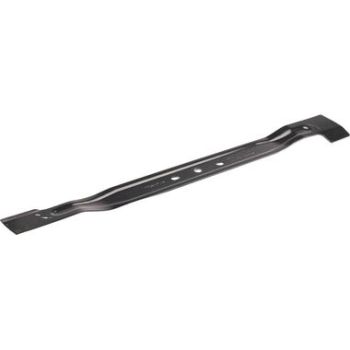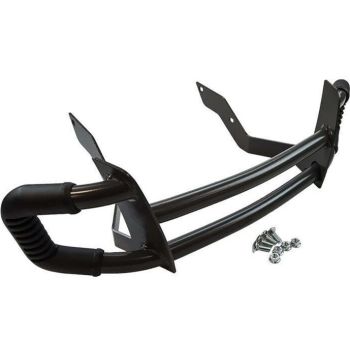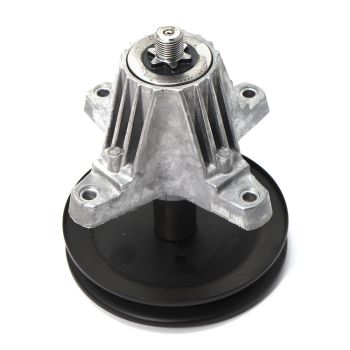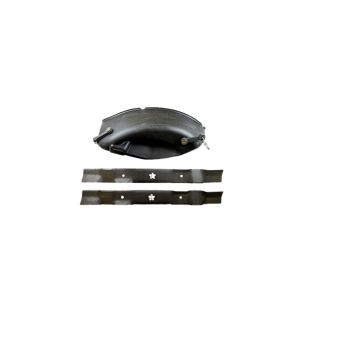A patchy, uneven lawn isn’t just an eyesore, it can also invite weeds, pests, and soil erosion. Whether you’re dealing with bare spots from pet damage, foot traffic, or harsh weather, the solution might be simpler than you think. Fast-growing grass seed is one of the easiest and most affordable ways to bring your lawn back to life quickly and effectively. With the right seed, you can go from sparse and spotty to lush and green in just a few weeks. In this guide, we’ll explore six of the best fast-growing grass seeds that are perfect for repairing and rejuvenating tired lawns. No matter your climate or lawn condition, there’s a seed here that can save your yard fast.
Why Fast-Growing Grass Seeds Matter
Fast-growing grass seeds offer a practical and effective solution for homeowners dealing with patchy, worn-out, or damaged lawns. These seeds germinate quickly, often within 5 to 10 days, helping you achieve a lush, green lawn in a fraction of the time.
Key Benefits of Fast-Growing Grass Seeds :
Quick Germination: Fills in bare spots rapidly, improving your lawn’s appearance in just days.
Weed Prevention: Rapid coverage helps prevent weeds from establishing in exposed soil.
Seasonal Recovery: Ideal for repairing damage caused by winter dieback, pets, or heavy foot traffic.
Great for Overseeding: Easily revives thinning lawns without the need for full replacement.
Water and Fertilizer Efficiency: Requires less water and nutrients to establish compared to slower-growing varieties.
Versatility: Many varieties adapt well to different soil types, moisture levels, and light conditions from full sun to partial shade.
Cost-Effective: Reduces the need for expensive lawn treatments or complete reseeding efforts.
Erosion Control: Quickly stabilizes soil on slopes or uneven terrain.
Pet and Child-Friendly: Creates a soft, safe surface for outdoor play in a short time.
Low Maintenance: Some varieties require less mowing and upkeep once established.
Whether you're patching up a few trouble spots or refreshing an entire lawn, fast-growing grass seed is a smart, low-maintenance solution that delivers fast, lasting results.
Signs Your Lawn Needs Fast-Growing Grass Seed
Recognizing when your lawn is patchy or thinning is key to restoring its health quickly. Fast-growing grass seed helps prevent weeds, soil erosion, and further damage by rapidly filling in bare spots.
Bare or Thin Patches: Large areas of exposed soil or sparse grass indicate your lawn needs quick reseeding.
Weeds Taking Over: Weeds thrive when grass coverage is thin. Fast-growing seeds fill gaps and crowd out unwanted plants.
Soil Erosion: Exposed soil on slopes or low spots is vulnerable to erosion. Fast-growing grass stabilizes the soil with dense roots.
Dead or Discolored Grass: Yellow or brown patches caused by pets, drought, or disease often require reseeding.
Slow Recovery After Stress: Lawns that struggle to bounce back after foot traffic or harsh weather benefit from fast coverage.
Spotting these signs early allows you to act swiftly with the right grass seed to save your lawn before problems worsen.
Top 6 Fast-Growing Grass Seeds to Quickly Repair and Revive Your Lawn
If your lawn is looking patchy or worn out, choosing the right fast-growing grass seed can make all the difference. These six top varieties have been proven to germinate quickly and thrive in a wide range of conditions. Discover which seeds can help you repair and revive your lawn faster than ever.
Perennial Ryegrass
Perennial ryegrass is one of the fastest germinating grass seeds, sprouting in as little as 5–10 days. It’s a favorite among homeowners and landscapers looking to overseed or repair thin areas quickly.
Key Benefits:
Germinates in under two weeks.
Dense, dark green blades.
Tolerates moderate foot traffic.
Ideal for overseeding existing lawns.
Ideal Conditions:
Prefers full sun to partial shade.
Thrives in cool, temperate regions.
Requires regular watering, especially when establishing.
Best for: Quick germination and cool-season climates.
Bermudagrass
If you’re living in a warm region and need a grass that can take a beating from kids, pets, or summer barbecues, bermudagrass is a top contender. It germinates in about 7–14 days and spreads aggressively via runners.
Key Benefits:
Heat and drought-tolerant.
Great for high-traffic areas.
Dense, carpet-like appearance.
Ideal Conditions:
Requires at least 6 to 8 hours of full light each day.
Grows well in the southern U.S. zones.
Not ideal for shady areas.
Best for: Warm-season climates and high-traffic areas.
Tall Fescue
Tall fescue offers a balance between fast growth and durability. It typically germinates in 7–12 days and performs well in a wide range of conditions, from shady backyards to sunny front lawns.
Key Benefits:
Deep root system for drought resistance.
Handles heat and cold well.
Grows well in sun or partial shade.
Ideal Conditions:
Works in transitional climate zones.
Suitable for both overseeding and full lawn installation.
Benefits of moderate irrigation.
Best for: Versatility and year-round performance.
Kentucky Bluegrass
Known for its rich color and ability to form a lush, dense lawn, Kentucky bluegrass is another great choice for homeowners in cooler climates. Though it’s slower to germinate (typically 14–30 days), once established, it spreads quickly via underground rhizomes, filling in bald spots over time.
Key Benefits:
Self-repairing via underground rhizomes.
Excellent cold-weather tolerance.
Thick, carpet-like growth.
Ideal Conditions:
Prefers full sun and well-drained soil.
Performs best in the northern U.S. zones.
Requires consistent watering during establishment.
Best for: Northern lawns with full sun.
Zoysia Grass
Warm-season grasses, such as zoysia, produce a thick, plush carpet that's perfect for lounging outside or going barefoot. It germinates within 14–21 days, and though it's slower than ryegrass, its thick growth habit makes it a powerful weed suppressant.
Key Benefits:
Very low maintenance once established.
Tolerates heat, drought, and heavy foot traffic.
Grows slowly, so less mowing is required.
Ideal Conditions:
Best for warm climates with plenty of sun.
Needs good soil drainage.
Not ideal for fast, short-term repair.
Best for: Southern lawns and low maintenance.
Creeping Red Fescue
If your lawn suffers from shady patches due to trees or structures, Creeping red fescue is your best choice. It germinates in 7–14 days, making it one of the faster options for shady spaces.
Key Benefits:
Tolerates heavy shade better than most grass types.
Grows quickly and spreads via rhizomes.
Minimal mowing required.
Ideal Conditions:
Cool-season grass is perfect for northern states.
Thrives in low-light areas.
Requires less water than other fescues.
Best for: Shady lawns and cooler climates.
How to Choose the Right Grass Seed for Your Lawn
Choosing the right grass seed is crucial for growing a thick, green, and resilient lawn. Different grass types are suited to different climates, soil conditions, and usage levels, so it's important to pick the one that matches your lawn’s needs. Here's how to make the best choice:
Key Factors to Consider:
Climate Zone:
Cool-Season Regions (USDA Zones 3–7): Opt for kentucky bluegrass, perennial ryegrass, or fine fescue.
Warm-Season Regions (USDA Zones 7–10): Choose bermudagrass, zoysia, or st. augustine grass.
Transitional Zones: Tall fescue is a great, adaptable choice.
Sunlight Exposure:
Full Sun: Use sun-loving grasses like bermuda grass or zoysia.
Shady Areas: Go for shade-tolerant grasses such as fine fescue or creeping red fescue.
Lawn Usage:
High-Traffic Zones: Choose durable grasses like tall fescue or perennial ryegrass.
Low-Use Ornamental Lawns: Focus on texture and color with grasses like Kentucky bluegrass.
Seed Mixes for Versatility:
Look for blended grass seed products that combine different types for better resilience, disease resistance, and adaptability.
Choosing the right seed ensures your lawn is not only beautiful but also sustainable and low-maintenance.
Common Mistakes to Avoid When Using Fast-Growing Grass Seed
Using fast-growing grass seed can quickly improve your lawn, but avoiding common mistakes is crucial to ensure success. The following are the primary risks to be aware of:
Poor Soil Preparation: Failing to remove debris and dead grass stops seeds from rooting well. Always clear and loosen the soil before planting.
Improper Watering: Seeds need consistent moisture, but not soggy soil. Water lightly multiple times daily until seedlings appear, then reduce.
Seeding at the Wrong Time: Extreme heat or cold lowers germination success. Plant in spring or early fall for cool-season grasses, late spring for warm-season grasses.
Overcrowding Seeds: Too much seed causes nutrient competition and weak growth. Stick to the recommended seeding rates on the package.
Neglecting Post-Seeding Care: Skipping fertilizing and mowing harms new grass development. Maintain patience and proper care for strong results.
Avoiding these mistakes gives your fast-growing grass seed the best chance to transform your lawn quickly and effectively.
Tips for Successful Lawn Repair with Fast-Growing Grass Seed
Repairing a patchy lawn with fast-growing grass seed can deliver impressive results if done correctly. To ensure successful germination and long-lasting growth, proper preparation and maintenance are key.
Start Preparing the Soil: Remove any dead grass, weeds, and debris from the patchy spots. Loosen the top 1–2 inches of soil using a rake or garden fork to promote better seed-to-soil contact, which is essential for germination.
Choose the Right Seed: Select a fast-growing grass variety that matches your region's climate and the conditions of your yard, such as sun, shade, or heavy foot traffic.
Seeding Evenly: Distribute the seed at the recommended rate to avoid overcrowding or sparse coverage. A broadcast spreader can help ensure an even application.
Water Consistently: Keep the soil consistently moist during the germination period, usually watering lightly 2–3 times per day until the seedlings are well-established.
Fertilize Properly: Use a starter fertilizer rich in phosphorus to support strong root development, but avoid over-fertilizing.
Mow Carefully: Wait until the grass reaches 3–4 inches tall before mowing for the first time, and never cut more than one-third of the blade length.
With the right approach, fast-growing grass seed can transform your lawn in just a few weeks.
Reviving a patchy lawn doesn’t have to be a long or expensive process. With the right fast-growing grass seed tailored to your region and yard conditions, you can quickly restore bare spots, improve your lawn's density, and enhance its overall appearance. Whether you need something tough for high-traffic areas or a shade-tolerant variety for under trees, the options above offer reliable, quick results. By pairing the right seed with proper lawn care like soil preparation, consistent watering, and mindful mowing, you’ll be well on your way to enjoying a thick, green, and healthy lawn in just a few weeks.
Struggling to fix those patchy spots in your lawn fast? WholeToolBox has everything you need to revive your yard, shop essential parts like lawn blades, aerator parts, and grass bags from trusted brands like Echo, Husqvarna, and Makita. Get lush results quickly with expert tools and supplies delivered straight to your door.
FAQs
How long does it take for fast-growing grass seed to fully establish?
While germination can occur in 5 to 14 days, depending on the variety, full establishment generally takes 4 to 8 weeks with proper watering and care.
Is fast-growing grass seed drought tolerant?
Some varieties, like bermuda grass and tall fescue, have good drought tolerance once established. However, all new grass seed needs consistent moisture during germination.
Can fast-growing grass seeds help prevent weeds?
Yes, by quickly covering bare soil, fast-growing grass seeds reduce the space available for weed seeds to germinate and take hold.














Validate your login